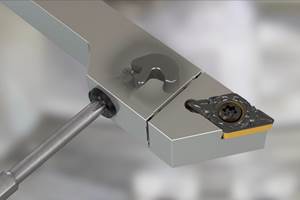Using Hard Turning To Reduce Grinding Time
A machine tool builder found that by hard turning its lathe spindle shafts extremely close to net shape, it could cut grinding time in half.
Share





For certain applications, hard turning can deliver tolerances and surface finishes that make grinding unnecessary. For extremely tight-toleranced jobs, hard turning can also serve as an effective pre-finishing operation. Machining a hardened part to within a few thousands of an inch of net shape speeds grinding by minimizing the amount of material that has to be removed.
That's precisely why Haas Automation's manufacturing facility in Oxnard, California, now hard turns its lathe spindle shafts prior to finish grinding. The company hard turns a variety of other machine components to final size and surface finish specifications, but this is the first time it has used hard turning as a pre-finishing operation. Not only has this made ID and OD grinding quicker, but it has also eliminated an interrupted grinding situation that resulted because of shaft surface distortion after heat treatment.
Distortion Dilemma
The company's move to integrate hard turning into its spindle shaft manufacturing process was spurred by the surface distortion problem. The unpredictable distortion made it difficult to accurately locate the inner and outer shaft diameters, which meant the grinding operations had to be set up for the worst case scenario (largest OD, smallest ID) in order to first knock down material high spots. Not only did this increase the number of passes required, but it also created a condition of interrupted grinding, which adversely affected wheel life.
Haas stocks one of its SL-40L CNC lathes with cubic boron nitride (CBN) inserts to turn the mid-50s Rc spindle shafts prior to grinding. The machine takes one pass each for inner and outer diameters with up to a 0.015-inch depth of cut. "Our hard turning process can deliver diameter tolerances of ±0.0003 inch, but requirements for the pre-finishing operation on the spindle shafts are not as tight," says Don Teller, Haas tooling manager. The cut takes the shaft diameters to between 0.003 to 0.005 inch of finish size, which reduces grinding time by 50 percent and extends wheel life.
The company does not use coolant when machining the spindle shafts. That's because the relatively deep depth of cut (DOC) creates a chip that is large enough to take out the majority of the heat generated by the cut, which is the objective in hard turning. When hard turning parts with critical tolerances at very small DOCs, however, the company floods the cutting zone with coolant. "In cases where the cutting depths are very small, the chip lacks the mass to carry out the heat that a larger chip would," says Mr. Teller. "Because additional heat is directed into the part, we use a high volume of coolant to maintain thermal stability and hold tolerances."
Such fine chips also have a tendency to "steel wool" around the tool tip, so flooding the cutting zone allows sufficient coolant to pass through the chips and reach the tool tip. "When OD hard turning, it is also helpful to deliver the coolant from opposite directions, if possible, in case chip wrapping occurs," says Mr. Teller. "High pressure coolant is another alternative, but you have to be precise in directing the coolant to the tool tip."
Ìý
Ìý
Related Content
Top Shops: Designing a Shop to Meet Customer Needs
Working closely with customers and making careful investments has enabled this Wisconsin machine shop to tackle difficult jobs with tight deadlines as a core part of its business.
Read MoreQuick-Change Tool Heads Reduce Setup on Swiss-Type Turning Centers
This new quick-change tooling system enables shops to get more production from their Swiss turning centers through reduced tool setup time and matches the performance of a solid tool.
Read MoreCustom Motorcycle Parts Made Here: Video Tour of a Family-Owned CNC Machine Shop
Lee Wimmer invited us to tour his second-generation family-owned machine shop in Perkasie, PA. This video explores the production processes behind precision-machined parts for both Wimmer Custom Cycle and LS Wimmer Machine Co., and shows how ingenuity and determination are still at the heart of American manufacturing. Today, both companies are now managed by Wimmer’s three sons.
Read MoreIndustry Analysis: Machining Semiconductor Components
With many machine shops anticipating long-term growth in demand from the semiconductor industry, it is worth the time to heed the advice of manufacturers who have already been servicing this end-market for years.
Read MoreRead Next
Last Chance! 2025 Top Shops Benchmarking Survey Still Open Through April 30
Don’t miss out! 91ÊÓƵÍøÕ¾ÎÛ's Top Shops Benchmarking Survey is still open — but not for long. This is your last chance to a receive free, customized benchmarking report that includes actionable feedback across several shopfloor and business metrics.
Read MoreAMRs Are Moving Into Manufacturing: 4 Considerations for Implementation
AMRs can provide a flexible, easy-to-use automation platform so long as manufacturers choose a suitable task and prepare their facilities.
Read MoreMachine Shop MBA
Making Chips and 91ÊÓƵÍøÕ¾ÎÛ are teaming up for a new podcast series called Machine Shop MBA—designed to help manufacturers measure their success against the industry’s best. Through the lens of the Top Shops benchmarking program, the series explores the KPIs that set high-performing shops apart, from machine utilization and first-pass yield to employee engagement and revenue per employee.
Read More






















